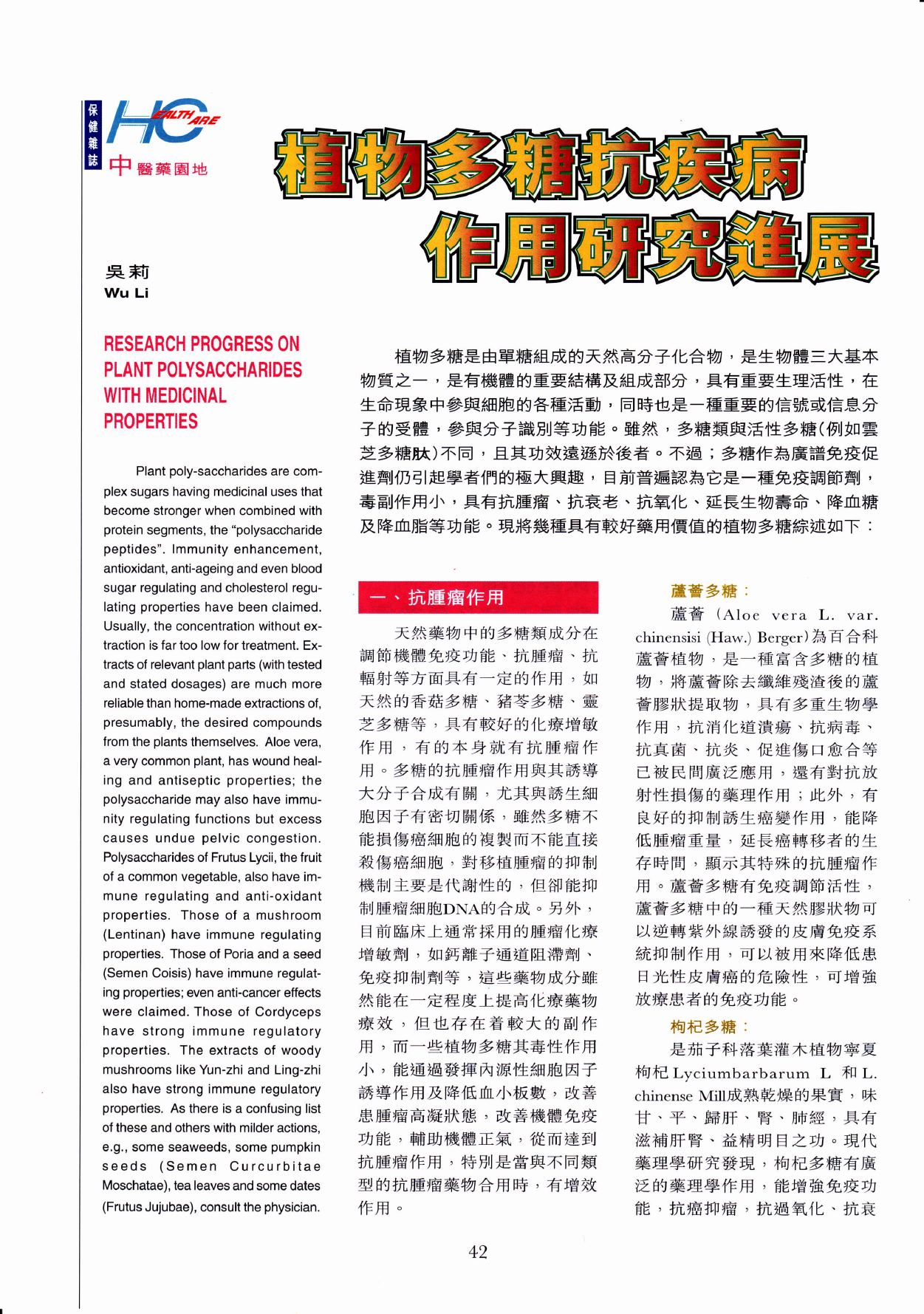
#
s*mnu
Ftl
Wu
Li
RESEARCH
PROGRESS ON
PLANT POLYSACCHARIDES
WITH MEDICINAL
PROPERTIES
Plant
poly-saccharides
are com-
plex sugars having medicinal uses
that
become stronger
when
combined with
protein segments, the "polysaccharide
peptides". lmmunity enhancement,
antioxidant, anti-ageing and even blood
sugar
regulating and
cholesterol
regu-
lating properties have been claimed.
Usually,
the concentration without
ex-
traction
is
far too low for treatment. Ex-
tracts of relevant
plant
parts
(with
tested
and stated dosages)
are
much more
reliable
than home-made extractions
of,
presumably, the desired compounds
from the plants
themselves.
Aloe vera,
a
very common plant, has wound heal-
ing
and antiseptic properties;
the
polysaccharide may also have
immu-
nity regulating functions but
excess
causes undue
pelvic
congestion.
Polysaccharides of
Frutus Lycii, the
lruit
of a common vegetable, also have im-
mune regulating and anti-oxidant
properties. Those of
a
mushroom
(Lentinan) have immune
regulating
properties. Those of
Poria and a seed
(Semen
Coisis)
have immune
regulat-
ing properties; even anti-cancer effects
were claimed. Those
of
Cordyceps
have
strong
immune
regulatory
properties. The
extracts
of
woody
mushrooms
like
Yun-zhi and Ling-zhi
also
have
strong immune
regulatory
properties.
As
there
is
a
confusing
list
of
these and others with milder actions,
e.9., some seaweeds, some
pumpkin
seeds
(Semen
Curcurbitae
Moschatae),
tea leaves and some
dates
(Frutus Jujubae), consult the physician.
+H+))J
*
M
FH
F+E*HF',t
H!
x
f
H 2'
+
(V,e
Wt,
E
E_M
W
-
tEA
+fr
lH*+4EE^?,#ffi
tr&+$fr
fr
'tEE+tbE-fEEgHt,f
=;Ftrl,f =-F.2^
2?ffi,W)TlE',E-Hrri{tr)6*&#
"
TiE
;
?ffiffHHitr*ft:FclB
iEA|I,|IJ
E
I
ftEF
#
{F5
H!
E
A
qTE,
E
Ef
EiEi,AH
E
E _
fEft Effi
Ffi
gII'
€Ef'fFH4'
'
^ElinffitF'+frF-*-.
fi-n5'fL,
. ftE+-+ttJ=ft
'
F+tr*E
e.F+trfl
E=+rheY"El4#E.HH{r*TH'Htra{Hffi
tEWt*)tBffifrtlT:
x.f*N+rt+fr\?ffiMFXhE
ffiJFFW,WtutrrhA?..
fnfr€rg
.
+n
x,f*frtrtr/F4ffi
-
ffi+?ffi-ffi.
24ffi+
,
H6&t+fr4Jltffil9ffi.
(F
m'
d
fr\
+
H
"tft.H
+fi.[F'M
tF
ffi
"
*ffifr\+rtEaffilFryre^H#€
xh
+
a
E\H
Ea,
)L
^tr
9)ffi
+,*fr
Eqtr+Htr+nffil
'BEr*?ffiT
ftY.+HEffiAfrfrEH!
iF
rym rA?.H.+*
49, TE
ffi
AW
EE,
Yt
1'TE,frEM
F!
+'II
ftlj
&ftf
+FE.1t#f,t4H!
'
I['dtfr?.+trt
frI]ffiMfrEEEDNAHlAl:I "
fr'1
,
jgetA|J
'
lrfiHET€€ptri#All
.
hfptr\
fttJqtl+,
E_'13
N+rJ
ffi,+
w
*fr?,ft-F.fEtrr
r€H
ttffi#+h
ffi-,&
,
{|Efr,EftE&A
#JHIJrc
.H'
m-$-b
tE"+rJ
*ffi
H#'l+(F
ffi
zJ',
FErEilE
4F+F
tt
lF'lS
AEEE
E+
--#
&
tF
ffi
eW
IE
tu
4,
tFW., tfr-#
,B[€,8H61ftflq'
e\.#ffi,Wtutr
rhfr\'
ffi
Eirffi
ffi iE
-R,,'(refri€?tJ
+fr.EFM
TF
H'
++E|J
EHE?A
Id
ffi
4JE\
fnffiE%+rJ
A
ffi
W'
H
lE
-'rf-
rcffi"
ffi€uffi:
H€ (eto"
vera
L.
var.
chinensisi
(Haw.) Berger)
HHAN
ffi€fH+rr
,
E-fEHe+ffiA\+H
+,J'
ffiHE
W
*
Affiffi,FJ5.lflfrlH
€Nryffi+FqYVJ,
HH *E+.+'J
ry
(F
H,
*iit5'fL€Yq*tr'
+fi.ffi#'
EltsF(HtrizffiH
,ffidyt+rtt'C
ht'l*ffi18fr\#wtFffi
;
rlv,tf
,H
Rlrg!+rpru
#
+.ffiffi(F
H,
frY.W
,fEE€,EEE, trtr-ffi++fb#
fr\
+
H
"
HE*ffiHft.tr.ffimi611r
,
H€&ffi
+
H!-46X
Y*Wtt+rrE
u
iE{.#
x,
|
fr,x#
#
a\
E
E
ft.fy
4
ffi+q!
ftI] TF
ffi
,
E
D)4E.HNIJ+{E,B
E
)b'l+
E
E
ffi
V!
fuFk'ft'
ET
Jg
9fi
nkffiH#fr4ttuEhfrU.
"
ffiE*ffi:
Effi+t+1&HWtr.tfl+rr+H
t6JfB
Lyci"mbarbarum
L
ftl
L.
chinense
MilFlF*+Uf*FtRF
,
ffi
ff.+.,EtrXT'ts.EfrfiS,RH
ifrffiETF.
ffi+FEE
trZIh
"
IF.,ft
NrFPffi
fr.Wril,
+frJte9
ffi
H
IH
ZfrtJ
#rEP
lF
H,
62rE
ffi
fu'trth
fru,
,
+fi.ffitfprg
,+hffiF"IV. - +nF
42


